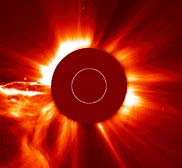New theory unravels magnetic instability

Reconnection, the merging of magnetic field lines of opposite polarity near the surface of the sun, Earth and some black holes, is believed to be the root cause of many spectacular astronomical events such as solar flares and coronal mass ejections, but the reason for this is not well understood. Researchers at Los Alamos National Laboratory now have a new theory that may explain the instability and advance the understanding of these phenomena.
Theorists Giovanni Lapenta of Los Alamos National Laboratory’s Plasma Theory group and Dana Knoll of the Lab’s Fluid Dynamics group presented their findings at the American Geophysical Union meeting in San Francisco at the Moscone Convention Center.
The theory is based on a 19th century mathematical observation called Kelvin-Helmholtz instability. “What we are trying to determine is why magnetic field lines loop out from the surface of the sun, reconnect and then fall back,” said Lapenta. “And why these systems, which look very stable, are in fact quite unstable.”
According to Lapenta, reconnection rates based on resistivity are orders of magnitude too slow to explain observed coronal reconnections. One possible mechanism that provides fast reconnection rates is known as “driven” reconnection-where external forces drive field lines together in a way that is independent of resistivity. Lapenta and Knoll believe that related work focused on magnetic field line reconnection in Earth’s magnetopause has shown that the Kelvin-Helmholtz instability can cause compressive actions that push field lines together and drive reconnection. “We propose that the same mechanism at work in the magnetopause could conceivably be at work in the solar corona and elsewhere,” said Lapenta.
In this theory, motion on the visible surface of the sun – the photosphere – leads to twisting deformation waves that move through the chromosphere, a layer of solar atmosphere just above the photosphere, growing larger as they move and emerging with a rapid increase of speed through the sun’s corona, or outer atmosphere. This rapid change in speed, or velocity shear, injected into the corona can cause magnetic loops to reconnect, according to Lapenta.
“We have conducted a series of simulations and shown that indeed reconnection can be achieved trough local compression driven by Kelvin- Helmholtz and that the reconnection rate is not sensitive to resistivity,” said Lapenta.
From this beginning point, Lapenta hopes to study the processes tied to motion on the surface of the sun to better understand why these “velocity shears” occur and how they move away from the sun and lead to CMEs and other solar events, and to apply this knowledge to better understanding the magnetic fields around the earth and the disc-shaped rotating masses, or accretion discs, that form around some black holes.
Los Alamos National Laboratory is operated by the University of California for the National Nuclear Security Administration (NNSA) of the U.S. Department of Energy and works in partnership with NNSA’s Sandia and Lawrence Livermore national laboratories to support NNSA in its mission.
Los Alamos enhances global security by ensuring the safety and reliability of the U.S. nuclear stockpile, developing technologies to reduce threats from weapons of mass destruction, and solving problems related to energy, environment, infrastructure, health and national security concerns.
Media Contact
More Information:
http://www.lanl.govAll latest news from the category: Physics and Astronomy
This area deals with the fundamental laws and building blocks of nature and how they interact, the properties and the behavior of matter, and research into space and time and their structures.
innovations-report provides in-depth reports and articles on subjects such as astrophysics, laser technologies, nuclear, quantum, particle and solid-state physics, nanotechnologies, planetary research and findings (Mars, Venus) and developments related to the Hubble Telescope.
Newest articles

Innovative 3D printed scaffolds offer new hope for bone healing
Researchers at the Institute for Bioengineering of Catalonia have developed novel 3D printed PLA-CaP scaffolds that promote blood vessel formation, ensuring better healing and regeneration of bone tissue. Bone is…

The surprising role of gut infection in Alzheimer’s disease
ASU- and Banner Alzheimer’s Institute-led study implicates link between a common virus and the disease, which travels from the gut to the brain and may be a target for antiviral…

Molecular gardening: New enzymes discovered for protein modification pruning
How deubiquitinases USP53 and USP54 cleave long polyubiquitin chains and how the former is linked to liver disease in children. Deubiquitinases (DUBs) are enzymes used by cells to trim protein…


